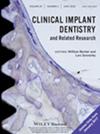Accuracy of the Yakebot dental implant robotic system versus fully guided static computer-assisted implant surgery template in edentulous jaw implantation: A preliminary clinical study
Abstract
Aims
To compare the accuracy of the Yakebot dental implant robotic system with that of fully guided static computer-assisted implant surgery (CAIS) template in edentulous implantation.
Materials and Methods
Thirteen patients with edentulous were recruited and divided into two groups: the Yake robotic system group (experimental) (n = 5) and the CAIS group (control) (n = 8). Postoperative cone-beam computed tomography (CBCT) was performed immediately, and the 3-dimensional positions of implants were obtained and compared with that in the preoperative design. The comparison showed platform, apical, depth, and angular deviations. A value of p < 0.05 was considered statistically significant.
Results
A total of 84 implants (36 in the robotic group and 48 in the CAIS group) were placed. The mean deviation at the implant platform, apex, depth, and angle in the CAIS group was 1.37 ± 0.72 mm, 1.28 ± 0.68 mm, 0.88 ± 0.47 mm, and 3.47 ± 2.02°, respectively. However, the mean deviation at the implant platform, apex, depth, and angle in the robotic group was 0.65 ± 0.25 mm, 0.65 ± 0.22 mm, 0.49 ± 0.24 mm, and 1.43 ± 1.18°, respectively. Significant differences in the four types of deviation (p < 0.05) between the two groups were observed.
Conclusion
The accuracy of robotic system in edentulous implant placement was superior to that of the CAIS template, suggesting that robotic system is more accurate, safe, and flexible, can be considered a promising treatment in clinical practice.

 求助内容:
求助内容: 应助结果提醒方式:
应助结果提醒方式:


